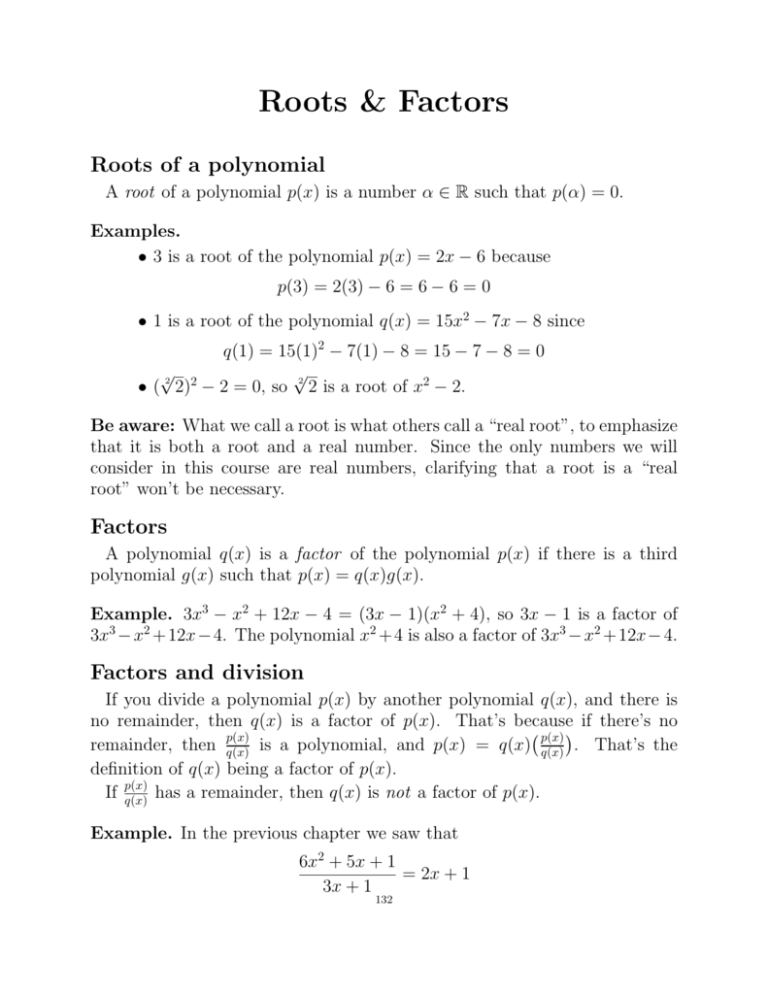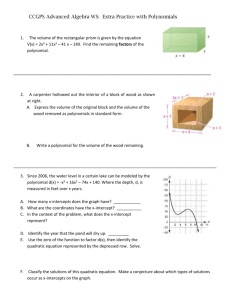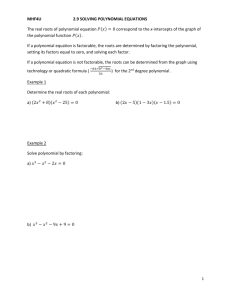Roots & Factors
advertisement

Roots & Factors Roots of a polynomial A root of a polynomial p(x) is a number ↵ 2 R such that p(↵) = 0. Examples. • 3 is a root of the polynomial p(x) = 2x p(3) = 2(3) 6=6 6=0 • 1 is a root of the polynomial q(x) = 15x2 p • ( 2 2)2 6 because q(1) = 15(1)2 7(1) 8 = 15 7 p 2 = 0, so 2 2 is a root of x2 2. 7x 8 since 8=0 Be aware: What we call a root is what others call a “real root”, to emphasize that it is both a root and a real number. Since the only numbers we will consider in this course are real numbers, clarifying that a root is a “real root” won’t be necessary. Factors A polynomial q(x) is a factor of the polynomial p(x) if there is a third polynomial g(x) such that p(x) = q(x)g(x). Example. 3x3 x2 + 12x 4 = (3x 1)(x2 + 4), so 3x 1 is a factor of 3x3 x2 + 12x 4. The polynomial x2 + 4 is also a factor of 3x3 x2 + 12x 4. Factors and division If you divide a polynomial p(x) by another polynomial q(x), and there is no remainder, then q(x) is a factor of p(x). That’s because if there’s no p(x) remainder, then p(x) q(x) is a polynomial, and p(x) = q(x) q(x) . That’s the definition of q(x) being a factor of p(x). If p(x) q(x) has a remainder, then q(x) is not a factor of p(x). Example. In the previous chapter we saw that 6x2 + 5x + 1 = 2x + 1 3x + 1 132 Multiplying the above equation by 3x + 1 gives 6x2 + 5x + 1 = (3x + 1)(2x + 1) so 3x + 1 is a factor of 6x2 + 5x + 1. * * * * * * * * * * * * * Most important examples of roots Notice that the number ↵ is a root of the linear polynomial x ↵ since ↵ ↵ = 0. You have to be able to recognize these types of roots when you see them. polynomial root x 2 2 x 3 3 x ( 2) 2 x+2 2 x + 15 15 x ↵ ↵ Linear factors give roots Suppose there is some number ↵ such that x ↵ is a factor of the polynomial p(x). We’ll see that ↵ must be a root of p(x). That x ↵ is a factor of p(x) means there is a polynomial g(x) such that p(x) = (x ↵)g(x) p(↵) = (↵ ↵)g(↵) Then = 0 · g(↵) =0 133 Notice that it didn’t matter what polynomial g(x) was, or what number g(↵) was; ↵ is a root of p(x). If x ↵ is a factor of p(x), then ↵ is a root of p(x). Examples. • 2 is a root of p(x) = (x p(2) = (2 2)(⇡ 7 x15 27x11 + 34 x5 x3 ) because 3 27(2)11 + 25 23 ) 4 3 27(2)11 + 25 23 ) 4 2)(⇡ 7 215 = 0 · (⇡ 7 215 =0 • 4 is a root of q(x) = (x 4)(x101 x57 17x3 + x) • 2, 1, and 5 are roots of the polynomial 3(x + 2)(x 1)(x 5). Roots give linear factors Suppose the number ↵ is a root of the polynomial p(x). That means that p(↵) = 0. We’ll see that x ↵ must be a factor of p(x). Let’s start by dividing p(x) by (x ↵). Remember that when you divide a polynomial by a linear polynomial, the remainder is always a constant. So we’ll get something that looks like p(x) c = g(x) + (x ↵) (x ↵) where g(x) is a polynomial and c 2 R is a constant. Next we can multiply the previous equation by (x ⇣ c ⌘ p(x) = (x ↵) g(x) + (x ↵) = (x ↵)g(x) + (x = (x ↵)g(x) + c 134 ↵) (x ↵) to get c ↵) That means that p(↵) = (↵ ↵)g(↵) + c = 0 · g(↵) + c =0+c =c Now remember that p(↵) = 0. We haven’t used that information in this problem yet, but we can now: because p(↵) = 0 and p(↵) = c, it must be that c = 0. Therefore, p(x) = (x That means that x ↵)g(x) + c = (x ↵)g(x) ↵ is a factor of p(x), which is what we wanted to check. If ↵ is a root of p(x), then x ↵ is a factor of p(x) Example. It’s easy to see that 1 is a root of p(x) = x3 1. Therefore, we know that x 1 is a factor of p(x). That means that p(x) = (x 1)g(x) for some polynomial g(x). To find g(x), divide p(x) by x 1: p(x) x3 1 g(x) = = = x2 + x + 1 x 1 x 1 3 2 Hence, x 1 = (x 1)(x + x + 1). We were able to find two factors of x3 1 because we spotted that the number 1 was a root of x3 1. * * * * * * * * * * * * * Roots and graphs If you put a root into a polynomial, 0 comes out. That means that if ↵ is a root of p(x), then (↵, 0) 2 R2 is a point in the graph of p(x). These points are exactly the x-intercepts of the graph of p(x). The roots of a polynomial are exactly the x-intercepts of its graph. 135 Examples. Examples. Examples. •• Below Examples. Below is is the the graph graph of of aa polynomial polynomial p(x). p(x). The The graph graph intersects intersects the the Examples. • Below is the graph of a polynomial p(x). The graph intersects the x-axis at 2 and 4, so 2 and 4 must be roots of p(x). That means that (x x-axis at• 2Below and 4,isso 2 and 4 must be roots of p(x). means intersects that (x 2) 2) the graph of a polynomial p(x). That The graph the • Below is the graph of a polynomial p(x). The graph intersects the x-axis at 2 and 4, so 2 and 4 must be roots of p(x). That means that (x 2) and (x 4) are factors of p(x). and (x at4)2 are p(x). x-axis andfactors 4, so 2 of and 4 must be roots of p(x). That means that (x 2) x-axis 2 and 4, so 2 and 4 must be roots of p(x). That means that (x 2) and (x at 4) are factors of p(x). and (x 4) are factors of p(x). and (x 4) are factors of p(x). •• Below Below is is the the graph graph of of aa polynomial polynomial q(x). q(x). The The graph graph intersects intersects the the x-axis at 3, 2, and 5, so 3, 2, and 5 are roots of q(x), and (x + 3), (x • Below is the graph of a polynomial q(x). The graph intersects the 3, 2, and 5, so 3, of 2, aand 5 are rootsq(x). of q(x), (x +intersects 3), (x 2), 2), x-axis at• Below is the graph polynomial Theand graph the and (x 5) are factors of q(x). x-axis at 3, 2, and 5, so 3, 2, and 5 are roots of q(x), and (x + 3), (x 2), and (x at5) are x-axis 3, 2,factors and 5,ofsoq(x). 3, 2, and 5 are roots of q(x), and (x + 3), (x 2), and (x 5) are factors of q(x). and (x 5) are factors of q(x). * * * * * * 107 *5 107 1365 * * * * * * Degree of a product is the sum of degrees of the factors Let’s take a look at some products of polynomials that we saw before in the chapter on “Basics of Polynomials”: The leading term of (2x2 5x)( 7x + 4) is 14x3 . This is an example of a degree 2 and a degree 1 polynomial whose product equals 3. Notice that 2+1=3 The product 5(x 2)(x + 3)(x2 + 3x 7) is a degree 4 polynomial because its leading term is 5x4 . The degrees of 5, (x 2), (x + 3), and (x2 + 3x 7) are 0, 1, 1, and 2, respectively. Notice that 0 + 1 + 1 + 2 = 4. The degrees of (2x3 7), (x5 3x + 5), (x 1), and (5x7 + 6x 9) are 3, 5, 1, and 7, respectively. The degree of their product, (2x3 7)(x5 3x + 5)(x 1)(5x7 + 6x 9), equals 16 since its leading term is 10x16 . Once again, we have that the sum of the degrees of the factors equals the degree of the product: 3 + 5 + 1 + 7 = 16. These three examples suggest a general pattern that always holds for factored polynomials (as long as the factored polynomial does not equal 0): If a polynomial p(x) is factored into a product of polynomials, then the degree of p(x) equals the sum of the degrees of its factors. Examples. • The degree of (4x3 + 27x 3)(3x6 • The degree of 7(x + 4)(x 1)(x 0 + 1 + 1 + 1 + 1 + 2 = 6. 27x3 + 15) equals 3 + 6 = 9. 3)(x 3)(x2 + 1) equals Degree of a polynomial bounds the number of roots Suppose p(x) is a polynomial that has n roots, and that p(x) is not the constant polynomial p(x) = 0. Let’s name the roots of p(x) as ↵1 , ↵2 , ..., ↵n . Any root of p(x) gives a linear factor of p(x), so p(x) = (x ↵1 )(x ↵2 ) · · · (x ↵n )q(x) for some polynomial q(x). Because the degree of a product is the sum of the degrees, the degree of p(x) is at least n. 137 The degree of p(x) (if p(x) 6= 0) is greater than or equal to the number of roots that p(x) has. Examples. • 5x4 3x3 + 2x 17 has at most 4 roots. • 4x723 15x52 + 37x14 7 has at most 723 roots. • Aside from the constant polynomial p(x) = 0, if a function has a graph that has infinitely many x-intercepts, then the function cannot be a polynomial. If it were a polynomial, its number of roots (or alternatively, its number of x-intercepts) would be bounded by the degree of the polynomial, and thus there would only be finitely many x-intercepts. To illustrate, if you are familiar with the graphs of the functions sin(x) and cos(x), then you’ll recall that they each have infinitely many x-intercepts. Thus, they cannot be polynomials. (If you are unfamiliar with sin(x) and cos(x), then you can ignore this paragraph.) 138 Exercises Exercises Exercises Exercises 1.) two roots (x 1.) Name Name two rootsofofthe thepolynomial polynomial (x 1)(x 1)(x 2). 2). 1.) Name two roots of the two polynomial 1)(x 2). (x 1.) roots the 1.) Name Name two roots of of (x the polynomial polynomial (x 1)(x 1)(x 2). 2). 2.) two polynomial (x 7)(x 3). 2.) Name Name tworoots rootsofofthe the polynomial (xx+3++ 7)(x 3). 2.) Name two roots of the polynomial (x +polynomial 7)(x 3)(x4 + 2x2 + x3). + 1). 2.) two (x 2.) Name Name two roots roots of of the the polynomial (x + + 7)(x 7)(x 3). 22 7 11 4 9 3.) four 2 polynomial 7 1 4(x+ 9)(x+ 2 21)(x 3.) Name Name fourroots rootsofofthe the polynomial +37737)(x + )(x 3443)(x )(x 2992)9 5252(x 3.) Name four roots of the polynomial (x+ )(x+ )(x )(x )(x +1). 2 1 4 3.) polynomial 5 3 2 2)(x + 3.) Name Name four four roots roots of of the the polynomial (x + + 33)(x + 22)(x )(x 33)(x )(x 22) 553(x ItIt will with #4-6 to that each polynomials from will help help withthat #4-6each to know know that each ofof the the polynomials from th t It will help withIt #4-6 to know of the polynomials from those will help with #4-6 to know that each of the polynomials from th It will help with #4-6 to know that each of the polynomials from t problems has that either 1,1,0,0,oror1.1. problems hasaaroot root thatequals equals either problems has a root that equals either 1, 0, or 1. Remember that if ↵ is a problems has a root that equals either 1, 0, or 1. problems has a root that equals either 1,p(x) 0, or 1. p(x) 33 root of p(x), then4.) is a polynomial and p(x) = (x ↵) x ↵Write x ↵ . and 4.) Writexx33++4x 4x 55as asaaproduct productofofaalinear linear andaaquadratic quadraticpolynom polynom 4.) Write x + 4x 5 as a product of a linear 4.) Write x + 4x 5 as a product of a linear and and aa quadratic quadratic polynom polynom 3 3 3 4.) Write x + 4x 5 as axxproduct a linearofand a quadratic polynomial. 5.) +x as aofproduct a linear and a quadratic polynomial. (H 5.) Write Write 33 +x as a product of a linear and a quadratic polynomial. (H 5.) Write x +x as a product of a linear and a quadratic 5.) Write x the +x as a productlaw of ahere.) linear and a quadratic polynomial. polynomial. (H (H could use distributive you could use the distributive law here.) 3 you 5.) Write x +x as a product of a linear and a quadratic polynomial. (Hint: you could use the distributive law here.) you could use the distributive law here.) 5 law here.) 4 3 2 you could use the6.) distributive Write 6.) Writexx555+ +3x 3x444++xx333 xx222 xx 11as asaaproduct productofofaalinear linearand andaaqua qua 6.) Write x + 3x + x x x 1 as a product of a linear and a qua 6.) Write x + 3x + x x x 1 as a product of a linear and a qu polynomial. polynomial. 4 3 2 6.) Write x5 +polynomial. 3x + x x x 1 as a product of a linear and a quartic polynomial. polynomial. 7.) 7.) The Thegraph graphofofaapolynomial polynomialp(x) p(x)isisdrawn drawnbelow. below. Identify Identifyasasmany manyror 7.) The graph of a polynomial p(x) is drawn below. Identify as many 7.)factors The graph of as aaspolynomial p(x) is drawn below. Identify as many rr and ofofp(x) you can. and factors p(x) you can. 7.) The graph and of a factors polynomial p(x) drawn of as can. and factors of p(x) p(x) asisyou you can.below. Identify as many roots and factors of p(x) as you can. 8.) 8.) The Thegraph graphofofaapolynomial polynomialq(x) q(x)isisdrawn drawnbelow. below. Identify Identifyasasmany manyror 8.) The graph of a polynomial q(x) is drawn below. Identify as many 8.) The graphand of8.) afactors polynomial q(x) is drawn Identify manyIdentify roots as many rr The graph ofas aaspolynomial q(x) is drawn as below. ofofq(x) you can. and factors q(x) you can.below. and of and factors of q(x) you can. andasfactors factors of q(x) q(x) as as you you can. can. 139 1086 108 6 For #9-13, determine the degree of the given polynomial. 9.) (x + 3)(x 2) 10.) (3x + 5)(4x2 + 2x 11.) 17(3x2 + 20x 3) 4) 12.) 4(x 1)(x 1)(x 13.) 5(x 3)(x2 + 1) 1)(x 14.) (True/False) 7x5 + 13x4 2)(x2 + 7)(x2 + 3x 3x3 7x2 + 2x 4) 1 has 8 roots. For #15-17, divide the polynomials. You can use synthetic division for #17 if you’d like. 15.) x6 2x5 + 6x4 16.) 2x3 + x2 + 4x 2x 1 17.) 2x3 + 4x x 2 10x3 + 14x2 x2 + 3 6 6 140 10x + 14







